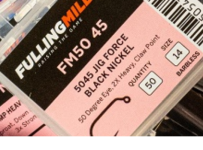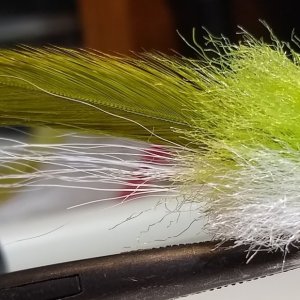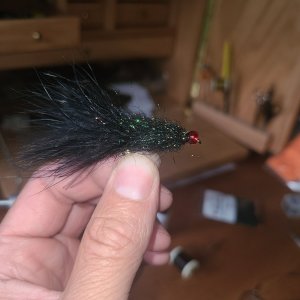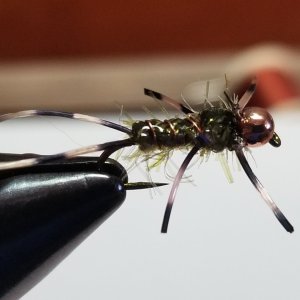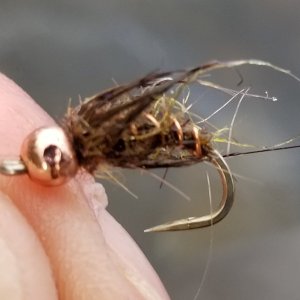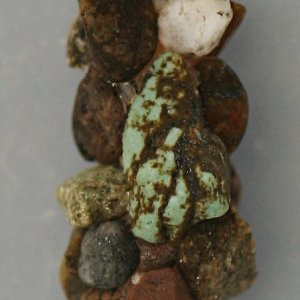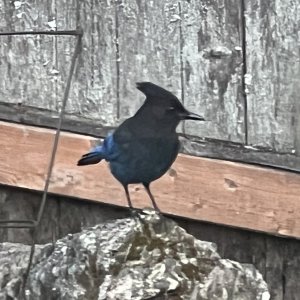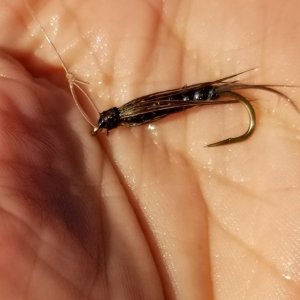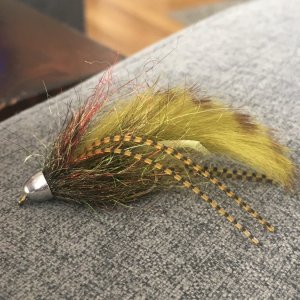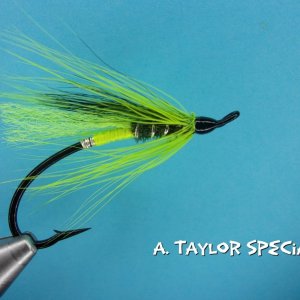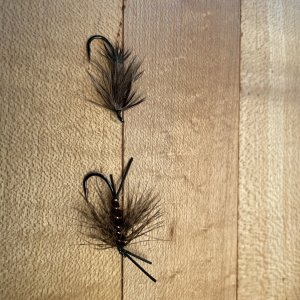Do jig hook flies need to be tied barb-up like a clouser? When stripping, I assume the hook-eye is pulled upward. Not a problem for a leech, but for a dragonfly nymph?
You are using an out of date browser. It may not display this or other websites correctly.
You should upgrade or use an alternative browser.
You should upgrade or use an alternative browser.
Jig Hook Fly Question
- Thread starter Wetswinger
- Start date
I thought I would tie some foam head dragon nymphs with the hook pointed up. Hopefully I could eliminate some snags Im having dragging these flies along the bottom. Foam head and underbody is supposed to suspended them slightly and hope upfacing hook helps...
Curious as to how that works out. I have found they hang up less than a standard hook.I thought I would tie some foam head dragon nymphs with the hook pointed up. Hopefully I could eliminate some snags Im having dragging these flies along the bottom. Foam head and underbody is supposed to suspended them slightly and hope upfacing hook helps...
I think @Buzzy ties up his carp flies similar to what you're thinking, he's probably got some good insight.
I thought the jig hook faces up as you strip it..Curious as to how that works out. I have found they hang up less than a standard hook.
I think @Buzzy ties up his carp flies similar to what you're thinking, he's probably got some good insight.
I'm interested to see the fly you come up with and how it works is what I getting at. It will ride point up. That's why it hangs up less, and the line in front works like a weed mover (a bit).I thought the jig hook faces up as you strip it..
I kinda wish I'd had some yesterday as the jig hooks seem to hang up less under an indicator in cover as well.
Last edited:
troutpocket
Stillwater strategist
Because the hook point rides up, you may have to invert the pattern when you are tying, if that makes sense. There are some patterns that I adapt to a jig hook that take a little extra work because the underside and shell back are reversed.
Good point. I tie mostly "in the round", but next time I sit I'm going to do some doc spratleys on the jig hooks.Because the hook point rides up, you may have to invert the pattern when you are tying, if that makes sense. There are some patterns that I adapt to a jig hook that take a little extra work because the underside and shell back are reversed.
Jig hooks and slotted beads aren't mandatory, to get a fly riding point up. In fact, they won't necessarily guarantee that they will.
With a regular hook and bead, most flies that are tied "in the round" will ride point up.

 troutbitten.com
troutbitten.com
It gets slightly more complicated, when you aren't tying in the round; if you have a buoyant material, only on the point side of the fly, there is a chance that it will negate the weight of the bead.
The main benefit of jig hooks is that they allow you to use slotted tungsten beads, which are heavier than brass or tungsten beads that have been drilled out.
With a regular hook and bead, most flies that are tied "in the round" will ride point up.

Nymph Hook Inversion -- And the Myth of the Jig Hook
You don’t need a jig hook to invert the nymph. In fact almost all nymphs invert, especially when weighted with a bead or lead.
 troutbitten.com
troutbitten.com
It gets slightly more complicated, when you aren't tying in the round; if you have a buoyant material, only on the point side of the fly, there is a chance that it will negate the weight of the bead.
The main benefit of jig hooks is that they allow you to use slotted tungsten beads, which are heavier than brass or tungsten beads that have been drilled out.
I'm using buoyant foam heads for suspension. The type 5 line sinks to the bottom and with short leader, the fly should be just a few inches off the bottom. Trying to get the barb face up to minimize snags...
I get you, like a boobie fly. If it floats eye up, I wonder if with the angled jig hook it will roll over when stripped?I'm using buoyant foam heads for suspension. The type 5 line sinks to the bottom and with short leader, the fly should be just a few inches off the bottom. Trying to get the barb face up to minimize snags...
Like this but with the hook point up? Sorry, on-line meetings so I'm filling time, hope I'm not screwing up the thread.
That's not the main purpose of a jig hook. Well it may be for Euro guys....But who cares about them?Jig hooks and slotted beads aren't mandatory, to get a fly riding point up. In fact, they won't necessarily guarantee that they will.
With a regular hook and bead, most flies that are tied "in the round" will ride point up.

Nymph Hook Inversion -- And the Myth of the Jig Hook
You don’t need a jig hook to invert the nymph. In fact almost all nymphs invert, especially when weighted with a bead or lead.troutbitten.com
It gets slightly more complicated, when you aren't tying in the round; if you have a buoyant material, only on the point side of the fly, there is a chance that it will negate the weight of the bead.
The main benefit of jig hooks is that they allow you to use slotted tungsten beads, which are heavier than brass or tungsten beads that have been drilled out.
The main purpose is hook point up and a jig action to a fly and maintaining that action all the way to the bottom where a lot of fish slurp it up...they like the jig action.
@Wetswinger I'm not sure a jig hook will work in the case you are mentioning because you are talking about a heavy sinking line, then a floating fly and a jig hook still facing up. It's different principles. But it's fun to play around. Go for it!
Pretty much this same type fly with the barb on top..
There are a few hooks like this, designed to ride point up.
Pretty much this same type fly with the barb on top..
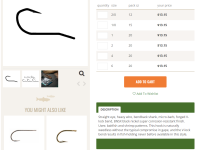
https://www.jsflyfishing.com/item/hk-070435-0000/umpqua-xs435-bendback-fly-hook/1.html
Last edited:
tkww
Steelhead
I'm starting to see Billy's point--the upwards kick of a jig hook actually going to work in the opposite way compared to the video.
Before you do anything else, take your normal non-"jig" hook, put it in the vice upside down (point/barb on top), and tie the pattern. That large foam underbody may be enough to keep the hook oriented that way when it's in the water. Try it out in the sink.
If it orients correctly, consider if you have enough hook gap left. (You've now tied in that bulky foam underbody between the shank and the point, absorbing some of the gap.) A close trim may help open it up, and/or you might have to find a hook with a little wider gap. If you do switch to a wider-gapped hook, I'd probably test the pattern again before I tied up a bunch. Widening the gap will increase the leverage of the bend/point mass, making it easier to rotate back around to a conventional orientation. Not saying that's what will happen, just that I'd try one and make sure it's still working before I tied up a bunch of them.
If you were using a floating line and the tippet was coming in from above, the jig style hook might offer some help in orientation. But tippet coming in level or even from underneath from a fully sunk line, the jig hook isn't going to offer you anything.
Before you do anything else, take your normal non-"jig" hook, put it in the vice upside down (point/barb on top), and tie the pattern. That large foam underbody may be enough to keep the hook oriented that way when it's in the water. Try it out in the sink.
If it orients correctly, consider if you have enough hook gap left. (You've now tied in that bulky foam underbody between the shank and the point, absorbing some of the gap.) A close trim may help open it up, and/or you might have to find a hook with a little wider gap. If you do switch to a wider-gapped hook, I'd probably test the pattern again before I tied up a bunch. Widening the gap will increase the leverage of the bend/point mass, making it easier to rotate back around to a conventional orientation. Not saying that's what will happen, just that I'd try one and make sure it's still working before I tied up a bunch of them.
If you were using a floating line and the tippet was coming in from above, the jig style hook might offer some help in orientation. But tippet coming in level or even from underneath from a fully sunk line, the jig hook isn't going to offer you anything.

